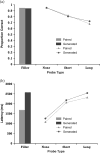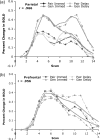Role of prefrontal and parietal cortices in associative learning
- PMID: 17675369
- PMCID: PMC5470781
- DOI: 10.1093/cercor/bhm123
Role of prefrontal and parietal cortices in associative learning
Abstract
Two studies were performed that compared a "Paired" condition in which participants studied paired associates with a "Generated" condition in which participants completed word fragments to produce paired associates. In both tasks, participants were responsible for memory of the material either studied or generated. The experiments revealed significant differences between the responses of a predefined prefrontal region and a predefined parietal region. The parietal region responded more in the Generated condition than the Paired condition, whereas there was no difference in the prefrontal region. On the other hand, the prefrontal region responded to the delay between study and test in both the Paired and Generated conditions, whereas the parietal region only responded to delay in the Generated condition. This pattern of results is consistent with the hypothesis that the parietal region is responsive to changes in problem representation and the prefrontal region to retrieval operations. An information-processing model embodying these assumptions was fit to the blood oxygen level-dependent responses in these regions.
Conflict of interest statement
Figures









Similar articles
-
An information-processing model of three cortical regions: evidence in episodic memory retrieval.Neuroimage. 2005 Mar;25(1):21-33. doi: 10.1016/j.neuroimage.2004.11.001. Epub 2005 Jan 25. Neuroimage. 2005. PMID: 15734340
-
Maintaining structured information: an investigation into functions of parietal and lateral prefrontal cortices.Neuropsychologia. 2008 Jan 31;46(2):665-78. doi: 10.1016/j.neuropsychologia.2007.09.015. Epub 2007 Oct 6. Neuropsychologia. 2008. PMID: 18022652
-
The dorsal prefrontal and dorsal anterior cingulate cortices exert complementary network signatures during encoding and retrieval in associative memory.Behav Brain Res. 2015 Sep 1;290:152-60. doi: 10.1016/j.bbr.2015.04.050. Epub 2015 May 7. Behav Brain Res. 2015. PMID: 25960314
-
Top-down and bottom-up attention to memory: a hypothesis (AtoM) on the role of the posterior parietal cortex in memory retrieval.Neuropsychologia. 2008;46(7):1828-51. doi: 10.1016/j.neuropsychologia.2008.03.022. Epub 2008 Apr 8. Neuropsychologia. 2008. PMID: 18471837 Review.
-
Neurobiology of Schemas and Schema-Mediated Memory.Trends Cogn Sci. 2017 Aug;21(8):618-631. doi: 10.1016/j.tics.2017.04.013. Epub 2017 May 24. Trends Cogn Sci. 2017. PMID: 28551107 Review.
Cited by
-
A rational account of memory predicts left prefrontal activation during controlled retrieval.Cereb Cortex. 2008 Nov;18(11):2674-85. doi: 10.1093/cercor/bhn027. Epub 2008 Mar 4. Cereb Cortex. 2008. PMID: 18321871 Free PMC article.
-
Using model-based functional MRI to locate working memory updates and declarative memory retrievals in the fronto-parietal network.Proc Natl Acad Sci U S A. 2013 Jan 29;110(5):1628-33. doi: 10.1073/pnas.1221572110. Epub 2013 Jan 14. Proc Natl Acad Sci U S A. 2013. PMID: 23319628 Free PMC article.
-
The role of chunk tightness and chunk familiarity in problem solving: evidence from ERPs and fMRI.Hum Brain Mapp. 2013 May;34(5):1173-86. doi: 10.1002/hbm.21501. Epub 2012 Feb 13. Hum Brain Mapp. 2013. PMID: 22328466 Free PMC article.
-
Approaches to Analysis in Model-based Cognitive Neuroscience.J Math Psychol. 2017 Feb;76(B):65-79. doi: 10.1016/j.jmp.2016.01.001. Epub 2016 Feb 17. J Math Psychol. 2017. PMID: 31745373 Free PMC article.
-
Lateral inferior prefrontal cortex and anterior cingulate cortex are engaged at different stages in the solution of insight problems.Proc Natl Acad Sci U S A. 2009 Jun 30;106(26):10799-804. doi: 10.1073/pnas.0903953106. Epub 2009 Jun 17. Proc Natl Acad Sci U S A. 2009. PMID: 19541657 Free PMC article. Clinical Trial.
References
-
- Alivisatos B, Petrides M. Functional activation of the human brain during mental rotation. Neuropsychologia. 1997;35:111–118. - PubMed
-
- Anderson JR. Human symbol manipulation within an integrated cognitive architecture. Cogn Sci. 2005;29:313–342. - PubMed
-
- Anderson JR, Bothell D, Byrne MD, Douglass S, Lebiere C, Qin Y. An integrated theory of mind. Psychol Rev. 2004;111:1036–1060. - PubMed
-
- Anderson JR, Qin Y, Stenger VA, Carter CS. The relationship of three cortical regions to an information-processing model. J Cogn Neurosci. 2004;16:637–653. - PubMed
-
- Anderson JR, Qin Y, Yung K-J, Carter CS. Information-processing modules and their relative modality specificity. Cogn Psychol. 2007;54:185–217. - PubMed
Publication types
MeSH terms
Grants and funding
LinkOut - more resources
Full Text Sources
Medical

